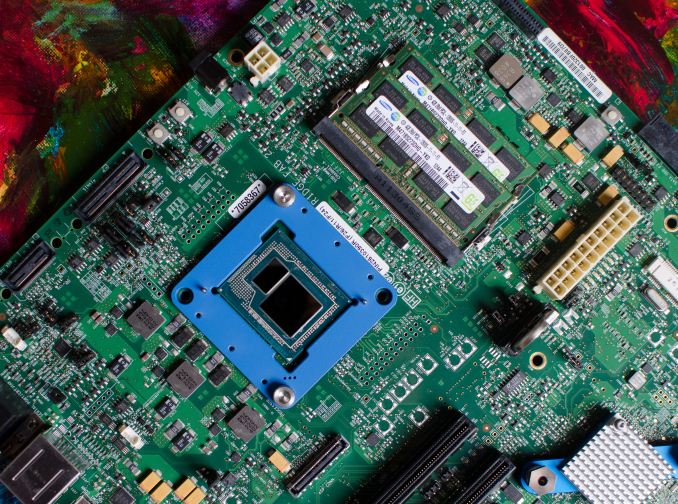Intel Iris Pro 5200 Graphics Review: Core i7-4950HQ Tested
by Anand Lal Shimpi on June 1, 2013 10:01 AM ESTFinal Words
For the past few years Intel has been threatening to make discrete GPUs obsolete with its march towards higher performing integrated GPUs. Given what we know about Iris Pro today, I'd say NVIDIA is fairly safe. The highest performing implementation of NVIDIA's GeForce GT 650M remains appreciably quicker than Iris Pro 5200 on average. Intel does catch up in some areas, but that's by no means the norm. NVIDIA's recently announced GT 750M should increase the margin a bit as well. Haswell doesn't pose any imminent threat to NVIDIA's position in traditional gaming notebooks. OpenCL performance is excellent, which is surprising given how little public attention Intel has given to the standard from a GPU perspective.
Where Iris Pro is dangerous is when you take into account form factor and power consumption. The GT 650M is a 45W TDP part, pair that with a 35 - 47W CPU and an OEM either has to accept throttling or design a cooling system that can deal with both. Iris Pro on the other hand has its TDP shared by the rest of the 47W Haswell part. From speaking with OEMs, Iris Pro seems to offer substantial power savings in light usage (read: non-gaming) scenarios. In our 15-inch MacBook Pro with Retina Display review we found that simply having the discrete GPU enabled could reduce web browsing battery life by ~25%. Presumably that delta would disappear with the use of Iris Pro instead.
Lower thermal requirements can also enabler smaller cooling solutions, leading to lighter notebooks. While Iris Pro isn't the fastest GPU on the block, it is significantly faster than any other integrated solution and does get within striking distance of the GT 650M in many cases. Combine that with the fact that you get all of this in a thermal package that a mainstream discrete GPU can't fit into and this all of the sudden becomes a more difficult decision for an OEM to make.
Without a doubt, gaming focused notebooks will have to stick with discrete GPUs - but what about notebooks like the 15-inch MacBook Pro with Retina Display? I have a dedicated PC for gaming, I use the rMBP for work and just need a GPU that's good enough to drive everything else in OS X. Intel's HD 4000 comes close, and I suspect Iris Pro will completely negate the need for a discrete GPU for non-gaming use in OS X. Iris Pro should also be competent enough to make modern gaming possible on the platform as well. Just because it's not as fast as a discrete GPU doesn't mean that it's not a very good integrated graphics solution. And all of this should come at a much lower power/thermal profile compared to the current IVB + GT 650M combination.
Intel clearly has some architectural (and perhaps driver) work to do with its Gen7 graphics. It needs more texture hardware per sub-slice to remain competitive with NVIDIA. It's also possible that greater pixel throughput would be useful as well but that's a bit more difficult to say at this point. I would also like to see an increase in bandwidth to Crystalwell. While the 50GB/s bi-directional link is clearly enough in many situations, that's not always the case.
Intel did the right thing with making Crystalwell an L4 cache. This is absolutely the right direction for mobile SoCs going forward and I expect Intel will try something similar with its low power smartphone and tablet silicon in the next 18 - 24 months. I'm pleased with the size of the cache and the fact that it caches both CPU and GPU memory. I'm also beyond impressed that Intel committed significant die area to both GPU and eDRAM in its Iris Pro enabled Haswell silicon. The solution isn't perfect, but it is completely unlike Intel to put this much effort towards improving graphics performance - and in my opinion, that's something that should be rewarded. So I'm going to do something I've never actually done before and give Intel an AnandTech Editors' Choice Award for Haswell with Iris Pro 5200 graphics.
This is exactly the type of approach to solving problems I expect from a company that owns around a dozen modern microprocessor fabs. Iris Pro is the perfect example of what Intel should be doing across all of the areas it competes in. Throw smart architecture and silicon at the problem and don't come back whining to me about die area and margins. It may not be the fastest GPU on the block, but it's definitely the right thing to do.
I'm giving Intel our lowest award under the new system because the solution needs to be better. Ideally I wouldn't want a regression from GT 650M performance, but in a pinch for a mostly work notebook I'd take lower platform power/better battery life as a trade in a heartbeat. This is absolutely a direction that I want to see Intel continue to explore with future generations too. I also feel very strongly that we should have at least one (maybe two) socketed K-series SKUs with Crystalwell on-board for desktop users. It is beyond unacceptable for Intel to not give its most performance hungry users the fastest Haswell configuration possible. Most companies tend to lose focus of their core audience as they pursue new markets and this is a clear example of Intel doing just that. Desktop users should at least have the option of buying a part with Crystalwell on-board.
So much of Intel's march towards improving graphics has been driven by Apple, I worry about what might happen to Intel's motivation should Apple no longer take such an aggressive position in the market. My hope is that Intel has finally realized the value of GPU performance and will continue to motivate itself.












177 Comments
View All Comments
HisDivineOrder - Saturday, June 1, 2013 - link
I see Razer making an Edge tablet with an Iris-based chip. In fact, it seems built for that idea more than anything else. That or a NUC HTPC run at 720p with no AA ever. You've got superior performance to any console out there right now and it's in a size smaller than an AppleTV.So yeah, the next Razer Edge should include this as an optional way to lower the cost of the whole system. I also think the next Surface Pro should use this. So high end x86-based laptops with Windows 8 Pro.
And NUC/BRIX systems that are so small they don't have room for discrete GPU's.
I imagine some thinner than makes sense ultrathins could also use this to great effect.
All that said, most systems people will be able to afford and use on a regular basis won't be using this chip. I think that's sad, but it's the way it will be until Intel stops trying to use Iris as a bonus for the high end users instead of trying to put discrete GPU's out of business by putting these on every chip they make so people start seeing it CAN do a decent job on its own within its specific limitations.
Right now, no one's going to see that, except those few fringe cases. Strictly speaking, while it might not have matched the 650m (or its successor), it did a decent job with the 640m and that's a lot better than any other IGP by Intel.
Spunjji - Tuesday, June 4, 2013 - link
You confused me here on these points:1) The NUC uses a 17W TDP chip and overheats. We're not going to have Iris in that form factor yet.
2) It would increase the cost of the Edge, not lower it. Same TDP problem too.
Otherwise I agree, this really needs to roll down lower in the food chain to have a serious impact. Hopefully they'll do that with Broadwell used by the GPU when the die area effectively becomes free thanks to the process switch.
whyso - Saturday, June 1, 2013 - link
So intel was right. Iris Pro pretty much matches a 650m at playable settings (30 fps +). Note that anandtech is being full of BullS**t here and comparing it to an OVERCLOCKED 650m from apple. Lets see, when intel made that 'equal to a 650m' claim it was talking about a standard 650m not an overclocked 650m running at 900/2500 (GDDR5) vs the normal 835/1000 (GDDR5 + boost at full, no boost = 735 mhz core). If you look at a standard clocked GDDR3 variant iris pro 5200 and the 650m are pretty much very similar (depending on the games) within around 10%. New Intel drivers should further shorten the gap (given that intel is quite good in compute).JarredWalton - Sunday, June 2, 2013 - link
http://www.anandtech.com/bench/Product/814For the games I tested, the rMBP15 isnt' that much faster in many titles. Iris isn't quite able to match GT 650M, but it's pretty close all things considered.
Spunjji - Tuesday, June 4, 2013 - link
I will believe this about new Intel drivers when I see them. I seriously, genuinely hope they surprise me, though.dbcoopernz - Saturday, June 1, 2013 - link
Are you going to test this system with madVR?Ryan Smith - Sunday, June 2, 2013 - link
We have Ganesh working to answer that question right now.dbcoopernz - Sunday, June 2, 2013 - link
Cool. :)JDG1980 - Saturday, June 1, 2013 - link
I would have liked to see some madVR tests. It seems to me that the particular architecture of this chip - lots of computing power, somewhat less memory bandwidth - would be very well suited to madVR's better processing options. It's been established that difficult features like Jinc scaling (the best quality) are limited by shader performance, not bandwidth.The price is far steeper than I would have expected, but once it inevitably drops a bit, I could see mini-ITX boards with this become a viable solution for high-end, passively-cooled HTPCs.
By the way, did they ever fix the 23.976 fps error that has been there since Clarkdale?
dbcoopernz - Saturday, June 1, 2013 - link
Missing Remote reports that 23.976 timing is much better.http://www.missingremote.com/review/intel-core-i7-...